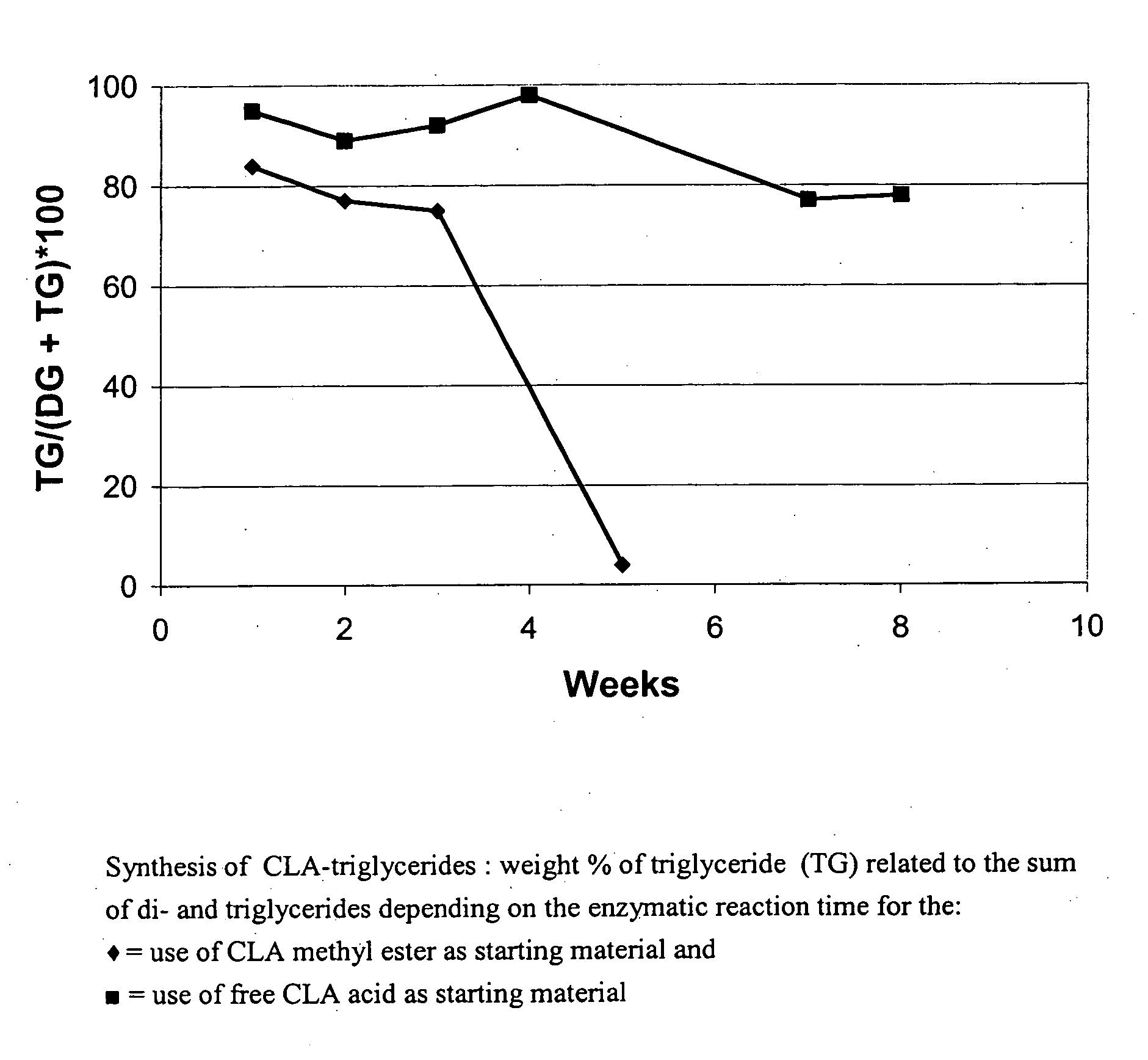Processes for the production of triglycerides of unsaturated fatty acids in the presence of enzymes
a technology of unsaturated fatty acids and enzymes, which is applied in the direction of fatty acid production, fatty acid esterification, fermentation, etc., can solve the problems of large quantity of basic catalysts, relatively slow reaction speed, and large quantity of secondary products and unwanted isomerizations, so as to improve the stability of enzymes and reduce the cost of the process. , the effect of reducing the cost of the process
- Summary
- Abstract
- Description
- Claims
- Application Information
AI Technical Summary
Benefits of technology
Problems solved by technology
Method used
Image
Examples
example 1
Comparison of the Stabilities of Novozym 435 in CLA Methyl Ester and CLA-Free Acid Under Operational Conditions
[0028] Glycerol (4 g) and CLA fatty acid (44 g) were weighed into one flask in a molar ratio of 1:3.6 while glycerol (5.5 g) and CLA methyl ester (66 g) were weighed into a second flask in a molar ratio of 1:3.7. After addition of Novozym® 435 (Lipase from Novozymes, Denmark; 4 g in batch 1 and 3 g in batch 2), a vacuum of 20 mbar was applied while stirring with a magnetic stirring fish at a temperature of 60° C. A sample of the oil phase is removed after 48 hours and analyzed by gas chromatography for the percentage of glycerides. Novozym 435 is removed from the CLA triglyceride formed by filtration and returned to the flask and another reaction is started under the same reaction conditions. Reactions are carried out over a period of 8 weeks in this way. The reaction starting with CLA methyl ester is carried out under nitrogen.
[0029] Results (see drawing): [0030] (♦)=use...
example 2
Selection of Suitable Lipases for the Pre-Hydrolysis of CLA Esters
[0033] 15 batches each containing 4 g of conjugated linoleic acid ethyl ester and 6 g of water were placed in a closable reaction vessel and simultaneously stirred at room temperature on a multiple stirring plate. 40 mg of commercially obtainable lipases or esterases were added to each of the batches. Samples were taken after 2 hours and 22 hours. The organic phase containing fatty acid ethyl ester and enzymatically hydrolyzed fatty acid were separated and analyzed. The conversion was determined through the acid number. The results are set out in Table 1.
TABLE 1Selection of suitable lipases and esterases for the process claimed in claim 1Acid valueConversionEnzymeMicroorganismManufacturer2 h22 h2 h22 hChirazym L-10Alcaligenes sp.Roche214111.520.5Lipase AAspergillus nigerAmano61638Novozym 868Candida antarctica ANovozymes562.53Novozym 525Candida antarctica BNovozymes52622630Lipomod 34Candida cylindraceaBiocatalysts45...
example 3
Hydrolysis of Short-Chain Conjugated Linoleic Acid Methyl Esters with Continuous Stripping of Water and Methanol
[0035] 100 g of conjugated linoleic acid methyl ester, 10 g of water and 5 g of immobilized Candida antarctica B lipase were introduced into a heatable flask. With a distillation bridge attached, the reaction was carried out under a reduced pressure of 60 mbar and at a temperature of 60° C. Water was continuously pumped into the flask at a flow rate of 0.25 ml / min. (Example 3A) and 0.5 ml / min. (Example 3B). Water added was quickly distilled off, so that the water content in the reactor was low (<20%) throughout the reaction. The conversion was monitored by determination of the acid value. The reactions were terminated after 24 hours (partial conversion) and the immobilized enzyme was filtered off from the reaction mixture. The organic phase was then separated from the aqueous phase. An acid value of 200 corresponds to a 100% conversion. The results are set out in Table 4....
PUM
| Property | Measurement | Unit |
|---|---|---|
| pressure | aaaaa | aaaaa |
| temperatures | aaaaa | aaaaa |
| temperatures | aaaaa | aaaaa |
Abstract
Description
Claims
Application Information
 Login to View More
Login to View More - R&D
- Intellectual Property
- Life Sciences
- Materials
- Tech Scout
- Unparalleled Data Quality
- Higher Quality Content
- 60% Fewer Hallucinations
Browse by: Latest US Patents, China's latest patents, Technical Efficacy Thesaurus, Application Domain, Technology Topic, Popular Technical Reports.
© 2025 PatSnap. All rights reserved.Legal|Privacy policy|Modern Slavery Act Transparency Statement|Sitemap|About US| Contact US: help@patsnap.com

